Each draft season, we try to bring you as many in-depth scouting reports as possible leading up to the draft. However, there were six players that were selected in the first round that we did not finish reports on. As such, we asked our team to submit more condensed reports on those six players so that every player drafted in this year’s first round has something filed.
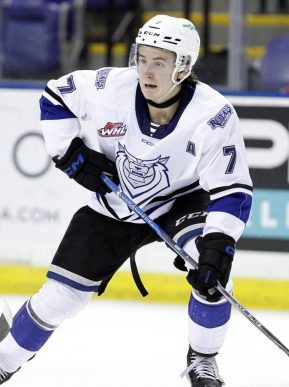 Cole Reschny - Center - Victoria Royals
Cole Reschny - Center - Victoria Royals
Drafted 18th by the Calgary Flames
By Derek Neumeier
Few prospects throughout the CHL — if any — had a stronger back half of their year than Reschny did in 2024-25. He was an all-around monster for the Victoria Royals, playing as their number one center and offensive linchpin, quarterbacking their powerplay, and handling a lot of tough matchups against the top players on other teams, including a head-to-head playoff showdown against Spokane Chiefs superstar Berkly Catton. It's hard to overstate just how much good work he did for that team, helping them to their best regular season record since 2015-16 and their first playoff series victory since 2018-19.
Reschny is one of the best puck managers to come up through the WHL in a while. First, he's deceptively strong for a slightly undersized forward, with an abundance of strength in his lower body and when bearing down on his stick. He then pairs those traits with buttery soft hands and superb peripheral awareness. Put those traits together it becomes incredibly difficult for opponents to win pucks away from him when he's really engaged, which is almost all of the time as someone who competes hard. If all that wasn't enough, he's also a top-tier playmaker who can easily find and connect difficult passes. He's a real expert at making the players around him look good, driving possession for his line and drawing defensive pressure until someone else gets open for a pass in a dangerous spot.
While Reschny has different parts of his game that are very appealing, there are still some imbalances as well. His shot usually isn't much of a threat, with a notable lack of power, though he at least possesses good precision and quick hands in tight. In other words, he can score, but not well from the medium distance or worse. His skating also leaves something to be desired, with a clear need for him to improve both his agility and straight-line speed before he turns pro.
When you step back and try to analyze Reschny’s overall long-term projection, the outlook is pretty optimistic. He already carries himself like a seasoned professional with the way that he approaches and thinks about the game, and there’s already a solid skill base that isn’t going to wane. Frankly, it would be shocking if he didn’t go on to become a longtime NHLer, as well as someone that goes on to be a core roster piece and maybe even wears a letter on his sweater. At the same time, though, it’s also hard to see him reaching as high of a ceiling as the other top prospects in this year’s draft class, as players with his matching limitations of size and skating don’t reach the highest echelons of the sport more often than not (with a few notable exceptions, of course, like Nick Suzuki and Kirill Kaprizov). Still, Reschny is a pretty special player already, and if he can find a way to add another gear to his skating as he develops, he could reach a whole new level entirely.
Skating
This short clip gives you a good idea of what Reschny’s skating is like, both the good and the bad. The balance and edges are pretty solid, and there’s nothing mechanically wrong with his skating. However, you can also see that he’s not especially quick with his movements. He creates space for himself like this all the time at the WHL level, but he’ll need to be able to execute these kinds of things a lot faster if he hopes to find similar success in the NHL one day.
Grade: 50
Shot
As mentioned above, Reschny’s goal-scoring contributions are mostly limited to when he gets in tight, but boy does he know how to finish when he does get there. This overtime, game-winning goal against Czechia at this spring’s U18 tournament was outright surgical.
Grade: 50
Puck Skills
Reschny can really feast when he’s on the powerplay. He’s just so naturally talented at receiving pucks, getting them under his control, and distributing passes however he sees fit. This is an elite pass to his teammate for an easy backdoor goal.
Grade: 55
Smarts
This clip highlights Reschny at his absolute best. Impeccable poise, awareness and timing by him to help open up this dangerous passing lane and connect with the target that he knew was going to be there. The opposing goalie never stood a chance.
Grade: 60
Physicality / Compete
Even though Reschny is on the smaller side he doesn’t shy away from battles or going into the dirty areas of the ice. There’s some real stockiness to him, and he knows how to get leverage and win body positioning against bigger opponents.
Grade: 50
OFP: 53.75
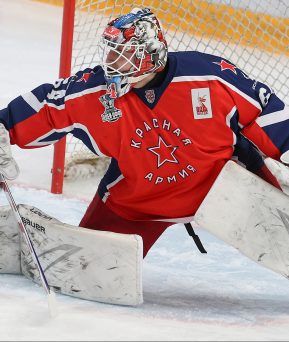 Pyotr Andreyanov - Goaltender - Krasnaya Armiya Moskva
Pyotr Andreyanov - Goaltender - Krasnaya Armiya Moskva
Drafted 20th by the Columbus Blue Jackets
By Liam Crouse
Pyotr Andreyanov was one of the biggest surprises from draft night, having been the first goalie taken off the board but also the 20th overall pick. But even though he may not have been our top goalie eligible for the draft, his potential to be a starter in the NHL is evident. He’s a highly athletic goalie, a phenomenal skater, and has also shown to be a solid play reader. But he still has drawbacks in his diminutive stature and erraticism. While he competes hard, his erraticism makes his job tougher, something he will have to clean up to succeed in the NHL
Athleticism
Andreyanov’s identity is speed and athleticism, and it’s vehemently shown in this clip. He’s playing a very low stance, which reduces mobility, but with his natural flexibility, he can still generate power. He exploded out of his low stance, stretching out with both leg and glove, robbing the shooter.
Grade: 60
Technique
While Andreyanov is aggressive and erratic, his technical foundation is great. Here, he starts by challenging the puck carrier way out of his crease. He then makes very subtle movements to re-adjust back to the top. Making a really strong push, he uses an economical route to cut through the crease. He gets his blocker down to stuff the shot as it’s in tight and makes a great save.
Grade: 55
Play Reading
While it may not always be present, Andreyanov has shown good flashes of reading the play. Here, due to it being a penalty kill and there are passing options, Andreyanov stays a little deeper. When the puck goes to his short-side post, he doesn’t fully commit. He deepens and wings his lead leg back in anticipation of the slot pass, and with quick tracking, he’s able to laterally release into a butterfly for a nice save.
Grade: 52.5
Compete/Temperament
Andreyanov’s erraticism can turn badly quickly, and it does here. He starts playing low and trying to look through traffic, and starts to panic, moving around too much. The extra slide he did put him in a bad spot where he couldn’t react to the loose puck, and he started to freak out by pushing too far. Being the hyper-competitor he is, he got back to his crease quickly and made a save, but the whole play was ugly
Grade: 52.5
Rebound Control
Rebounds are a weakness of Andreyanov, and you can see here how he just allows the puck to bounce off his chest without reacting with his glove to suppress it at all.
Grade: 47.5
Puck Skills
Andreyanov is an average puck player, mostly only being active on power plays like here, but even though he isn’t aggressive in moving the puck, he can still make a tape-to-tape pass when needed.
Grade: 50
OFP: 53.375
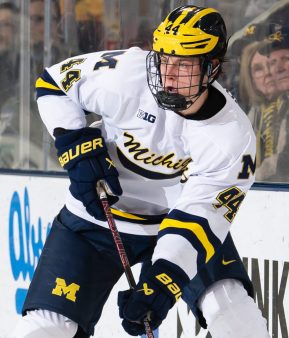 Will Horcoff - Center - University of Michigan
Will Horcoff - Center - University of Michigan
Drafted 24th by the Pittsburgh Penguins
By Brock Otten
The son of former Edmonton Oiler two-way standout Shawn Horcoff, Will is an intriguing, but raw centerman cut from a similar cloth. He made the gutsy decision to leave the U.S. NTDP half way through the year to join the Michigan Wolverines early and that decision paid off in a big way, as it allowed Horcoff to shine on a greater stage. He also returned to the U.S.’ U18 team at the end of the year at the IIHF U18’s, playing a key role en route to a bronze medal. It was this late season surge, in combination with his immense physical upside, that made Horcoff an attractive first round selection and late season riser on many lists.
At the University of Michigan, Horcoff impressed with his work on the powerplay, demonstrating strong offensive zone awareness and a willingness to get to the net and work the half wall to extend possession. At the U18’s, Horcoff impressed with his ability to create coming out of the cycle, showing great vision and passing ability coming off the wall. Despite still being slight, he protected the puck well, shielding defenders to extend possession and exhibited poise with the puck, again, showcasing a high IQ as an offensive player. However, at the NCAA level, Horcoff hasn’t been able to be as consistent winning those 50/50 battles and his even strength production and scoring chance generation lagged because of this. Horcoff also needs to upgrade his quickness. With his long legs, he can build to an adequate top speed that does allow him to carry in transition and get to the net. However, his edgework and explosiveness need to improve in a big way to make him a more difficult cover. As his conditioning improves and his frame fills out, he should be able to improve at least his power generation.
As Horcoff develops, both physically and from a skill perspective, he projects to be a very versatile player. He has shown the ability to play both center and the wing. He can play a variety of roles on the powerplay, including netfront. His reach, two-way awareness, and improving competitiveness should also make him a very good defensive player, much like his father. Of course, upgrading his quickness will be the key, but that should happen after a few years in college.
From a projection standpoint, Horcoff could develop into a quality middle six player who can be utilized in any situation. Identifying his true upside currently is a difficult task considering how underdeveloped he is physically. When that frame is filled out and he’s playing at 6’5, 225+, he could be an entirely different player and that’s what the Pittsburgh Penguins are banking on.
Grades:
Skating: 50
Shot: 52.5
Skills: 55
Smarts: 55
Physicality/Compete: 55
OFP: 53.625
VIDEOS
Horcoff’s first point as a Wolverine after leaving the NTDP. He showcases his strong vision from the wall as he sets up a goal from behind the net.
Strong defensive effort and awareness from Horcoff here. He hustles to support the backcheck and reads the drop along the wall. He then makes a quick transition up ice.
Horcoff is skilled enough to be a strong transitional player once his skating picks up. Again, we love how he attacks the middle of the ice consistently.
Quick play coming off the wall as Horcoff, again, gets himself into the middle of the ice. His shot shows a lot of promise, but his release needs work as he has a tendency to heel or misfire shots, especially under duress.
A good look at Horcoff’s inability to build speed. He tries to accelerate out of a pivot, but his footwork isn’t clean and he gets bottled up in the neutral zone. Credit to Horcoff for staying with the play to get it out of the neutral zone.
Horcoff’s game offensively is predicated on those quick touches. Great two-man game here as he works to the inside and draws a penalty. Although, again, you see the lack of quickness as he can’t create separation to earn a clean look.
Another impressive passing play by Horcoff, again showcasing his vision and ability to make decisions quickly.
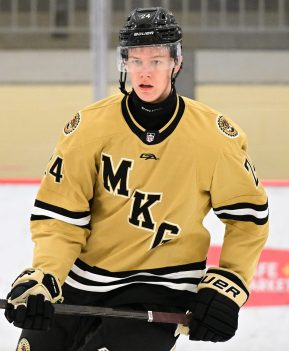 Vaclav Nestrasil - Wing - Muskegon
Vaclav Nestrasil - Wing - Muskegon
Drafted 25th by the Chicago Blackhawks
By Kaeden Ireland
Vaclav Nestrasil played his first full season in North America this year with Muskegon and made vast strides in development. His improvements and adjustments to the USHL were very visible, and to cap it off, Vaclav also finished 8th in league playoff scoring with 13 points in 14 games.
Nestrasil projects to be a defensively responsible middle-six winger who competes hard every shift. He has some offensive potential with his hands, shot in tight, and creativity with the puck.
Skating
Nestrasil’s skating is unorthodox, but he makes it work with his effort level and pace once he gets up to speed. One key area Nestrasil must improve is his acceleration.
Nestrasil could use some work cleaning up his acceleration, as seen in this clip.
Skating: 52.5
Shooting
Vaclav’s wrist shot lacks consistency; he won’t be a primary shooting threat from the wing, but on rebounds and loose pucks, he does a good job of getting low and elevating shots into the upper third of the net to beat goalies. Nestrastil’s snapshot is a nice alternative to his wrist shot, as he can catch goalies off guard with rather unpredictable, snappy shots down low.
A nice clean finish with time by Nestrasil.
Shooting: 55
Smarts
Nestrasil isn’t afraid to try more elaborate passes, often looking to pass through the bodies of defenders to his teammates for shooting opportunities. His passes can come off as a bit panicky, but his decision making did slightly improve over the past season. I would like to see Nestrasil learn to find safe outlets more consistently as he’s struggled with turnovers.
Smarts: 50
Skills
Nestrasil can pull off some very impressive moves, but like his passing abilities, he turns the puck over far too frequently. For a 6’6 forward, protecting the puck when attacking a defender head-on will be more difficult due to the longer stick, so he will need to learn to use his body to protect the puck better.
Nestrasil showcases his creativity with this fun deke to get away with the puck down low.
Skills: 55
Compete/Physicality
Vaclav is still a physical project. He stands at 6’6 but weighs under 190 pounds at the moment, leaving plenty of room to add to his frame. Nestrasil makes his physical presence known by putting his body on opponents, whether it be small bumps away from play or big hits that put defensemen on the ice; Nestrasil puts every inch of his 6’6 frame to use. No doubt, his growing physical dominance is one reason why he went as high as 25th overall. It’s encouraging to see how in post-draft interviews Nestrasil emphasized how coachable he was when improving his physical game, leaning on Muskegon staff to noticeably get rougher and more chippy down the stretch.
Massive hit here to catch the Waterloo defenseman on a recovery.
Nestrasil competes for pucks constantly, using his long reach to close gaps and put the heat on puck carriers, forcing them to pass off or face a barrage of stick checks. Nestrasil’s compete makes him a likely bet to crack Chicago’s top penalty-kill unit in the future. His forechecking and backchecking also stand out as noteworthy traits that suit him to an NHL middle-six role.
While Vaclav does give up the middle of the ice here on the PK, he recovers by charging over and getting the block before making a great pass to his trailing teammate.
Compete/Physicality: 55
OFP: 53.375
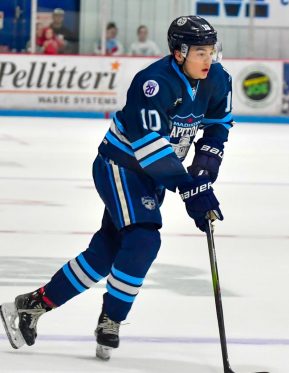 Ryker Lee - Wing - Madison Capitals
Ryker Lee - Wing - Madison Capitals
Drafted 26th by the Nashville Predators
By Jamison Derksen
Ryker Lee was one of the top offensive players in the USHL this season, finishing fourth in the league scoring race with 68 points. His Madison Capitols improved from being a fringe playoff team in 2023/24 to being in contention for first place in the East, thanks in large part to the infusion of offense brought by Lee. The Nashville Predators liked what they saw from him this season, and made him the 26th Overall selection in the 2025 NHL Entry Draft. Lee is a high risk / high reward pick, as his skating and defensive game need a lot of work, but he is among the most skilled players in the draft. It is worth noting that Lee hit a huge growth spurt recently, as he was listed at 5’4 heading into the 2022/23 season, so there is plenty of room for development in the physical game, as well as his skating. Right now as a pro he projects to be a middle-six winger that contributes on a top powerplay unit.
Skating:
Lee’s skating is certainly his biggest knock right now. When he’s not in a full-out sprint, he straightens up his stance quite a bit and can go shifts without displaying anything resembling pace at all. His acceleration is also a struggle, but once he gets going, his speed is average in the USHL. Obviously, that will need to improve in order for him to have an NHL career.
Grade: 50
Shot:
Ryker Lee is dangerous as a shooter, particularly with his wrist shot in the USHL. He scores a lot off of wrist shots around the top of the right circle, but when he’s not the puck carrier, he often finds ice in the slot. His slapshot is only for one timers, and is seldom used, despite its effectiveness. One improvement Lee will need to make to his wrist shot is that he needs to shorten his reach back when loading, it makes him too easy to read at times and takes too much time to get a shot off.
Grade: 55
Skills:
Lee is among the most talented players in the 2025 draft class. His puck control and creativity are fantastic, and he is able to handle tough passes with no problem at all. Lee loves to challenge defenders one-on-one as a puck carrier, and often makes them look silly. However, he does have a tendency to overhandle the puck, so he can definitely stickhandle himself into positions where he is on the outside and isn’t really a threat. This is a junior habit that will need to be broken.
Grade: 57.5
Smarts:
Lee’s hockey IQ is a bit of a mixed bag. One of the things he’s best at is drawing opponents to himself to create space for teammates. He also has the aforementioned issue of overhandling the puck, though he has shown the ability to adapt on the fly and make a new play when he stickhandles himself into trouble. Positionally, he finds space excellently in the offensive zone, whereas in his own zone he can be pretty spotty.
Grade: 52.5
Physical/Compete:
Right now, Lee doesn’t shy away from physical play, but he does need to get stronger. He will throw the occasional check, but often gets outmuscled and pushed around in puck battles. His soft hands with the puck can also result in some dangerous turnovers when they don’t end up on the highlight reel. He will also need to work on being engaged defensively with more consistency, especially given that he likes to take liberties with the puck.
Grade: 50
OFP: 53
 Mason West - Wing - Fargo Force/Edina High
Mason West - Wing - Fargo Force/Edina High
Drafted 29th by the Chicago Blackhawks
By Brock Otten
West was one of the draft’s most heavily discussed players this year for a variety of reasons. Firstly, his in-season improvement and end of the season play in the USHL helped to propel him up draft boards based on his raw tools and physical upside. On our draft board, West went from an honorable mention outside of our top 100 (at midseason) to 49th on our final rankings. Secondly, the discourse surrounding his future as a football player and desire to play football again next year has brought about concerns. Leading up to the draft, West committed to Michigan State for hockey and this helped to alleviate some concerns that he would pick football. However, he still intends to return to Edina High to start at quarterback for his senior year. The concerns here are three-fold. For one, West could get hurt. For two, West will be repeating the high school hockey level for much of the year, likely splitting between Edina High and Fargo again. For three, if West performs at a high level in football, will a highly regarded school come calling with a scholarship and NIL money, forcing West to re-evaluate his sporting future?
Regardless of the above, it was plainly obvious that a team would opt to select West in the first round given his tantalizing upside and the Blackhawks did just that. West compares himself to Anders Lee of the New York Islanders and that’s fitting considering Lee once had to make a similar choice surrounding football and potential scholarship offers.
West’ high end athleticism is visible on the ice. He’s a big kid who moves very impressively. Builds to a solid top speed moving North/South, but has refined balance and edgework that allows him to put defenders on his back to protect the puck in motion. For that reason, he’s a tough check for high school defenders right now; near impossible for them to separate him from the puck. He also was successful in beating USHL defenders the same way later in the season. West shows strong vision with the puck and a clear understanding of how to use his size to be a factor away from the puck. He could probably stand to get to the net and play through the middle a bit more often, however, he forechecks and backchecks with ferocity. We wouldn’t call him an overly physical player (perhaps shocking given his football background), but maybe that’s something he grows into. His shot shows promise if he can work on his release; it’s heavy, but he can have a tendency to whiff under pressure. From a skill perspective, again, there’s upside. He handles impressively well at full speed for a big man, although he can keep the puck too far out, leaving him susceptible to stick checks. He needs to operate more in his hip pocket, using his size to his advantage in transition.
So, what is West’s upside? The Anders Lee comparison is apt. In a best-case scenario, West develops into a similar kind of impactful, well-rounded player. Yes, there are concerns; the ones we outlined above. However, repeating the USHL (or even finding a WHL program to close out the season with) will not be a bad thing for West who is still quite raw. We saw the difficulty that a similar kind of player in Dean Letourneau had jumping to the NCAA this year out of prep. In the long run, Michigan State is a great landing spot for West and in three-four years, he could end up looking like a real steal for the Blackhawks.
Grades:
Skating: 55
Shot: 50
Skills: 55
Smarts: 55
Physicality/Compete: 52.5
OFP: 53.625
VIDEOS
At the high school level we see West’s quick strike ability as he jumps on a loose puck and generates a high end scoring chance.
Again, at the high school level, West’s frame and reach are at work as he plays through a defender to make a pass to the slot that results in a goal.
The rest of the clips are all from his time in the USHL with Fargo. Both clips here showcase West’s speed and athleticism and how it can impact the game off the puck. He disrupts a clean zone entry and he closes ground quickly on the forecheck.
How about an NBA style box out to help initiate the breakout?
A terrific play on the forecheck as West gets inside leverage, secures possession, which in turn leads to a scoring chance from the slot.
A look at West’s ability to create off the rush, but the pass is just a bit behind his teammate, and they can’t connect. The precision on his passes will be an area of focus for him.
A note on the 20-80 scale used above. We look at five attributes (skating, shooting, puck skills, hockey IQ and physicality) for skaters and six for goalies (athleticism/quickness, compete/temperament, vision/play reading, technique/style, rebound control and puck handling). Each individual attribute is graded along the 20-80 scales, which includes half-grades. The idea is that a projection of 50 in a given attribute meant that our observer believed that the player could get to roughly NHL average at that attribute at maturity.































